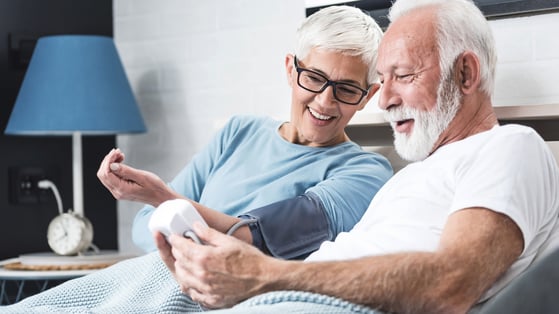Back to articles
Can remote patient monitoring improve the quality of healthcare?

The COVID-19 pandemic has accelerated the need for remote patient monitoring. New technologies that emerge from this need can forever improve healthcare and healthcare systems.
At the heart of the evolution, IoT-enabled devices and platforms are dramatically reducing face-to-face patient contact while enhancing the quality of care provided. This has been especially useful for individuals who require post-operation monitoring, the elderly and vulnerable, and those with chronic conditions or who struggle to travel.
Sharing data with doctors via Bluetooth LE
First utilized in 1967 to transmit electrocardiograms (ECGs) over telephone wires and then trialed in the 1970s for those in rural communities, the concept of remote patient monitoring has come a long way. Currently, remote automated monitoring (RAM) allows patients to record their vital signs from home using small and discrete sensors.
The information travels via a hub or gateway to their cloud-based online health record platform of choice. The doctor has a complete overview of the patient's condition. Thanks to wireless connectivity, designated clinicians can uncover irregularities and risk factors no matter where the patient is located.
For instance, Stel Life’s Vitals Hub can connect to body-worn sensors via Bluetooth LE then send this information to the Cloud over a cellular network. Other implementations can help alleviate chronic conditions, such as Aptar Pharma’s Connected Device for Metered Dose Inhalers, which records when the patient last used an asthma inhaler and how. This data is forwarded via Bluetooth LE to the BreatheSmart app, where the patient's doctor can view it.
Reliable collection and transmission of the data is obviously essential, but effectively filtering the information received is also crucial. Mayo Clinic Consultant Virend Somers explains that the sheer amount of data can be overwhelming to healthcare professionals and that sophisticated programs are key to identifying trends and anomalies in these vital signs. As a result, any at-risk patients can be identified for re-admission or additional care.
New technology reduces re-admissions
While protecting at-risk patients is essential, where possible, the goal is also to reduce the number of patients in hospital at any given time. To that end, RAM has been trialed at McMaster University in Canada, with a study involving over 900 post-op patients—half of whom were provided with self-monitoring technology—using a tablet to measure their blood pressure, heart rate, and oxygen saturation for 30 days.
Those in the self-monitoring group were found to be less likely to report to the hospital for re-admission (22 percent vs. 27 percent) and were more likely to have any medication errors detected (30 percent vs. 6 percent).
By reducing hospital re-admission, bed occupancy levels will also decrease, putting less strain on the system. Moreover, because healthcare has often needed to occur at arm's length throughout the pandemic, remote monitoring has been invaluable in ensuring a high level of care is maintained.
Remote automated monitoring (RAM) can predict illness
As we move forward and extend the capabilities of RAM, it is now becoming possible to predict illness before symptoms even appear. In a study conducted by Emilia Grzesiak and others, published through Jama Network Open, 49 patients trialed a non-invasive smartwatch with the capacity to monitor and record their vital signs. The participants were then exposed to either the H1N1 virus or human rhinovirus. The device was able to detect the presence of the H1N1 virus with 92 percent accuracy and the rhinovirus with 89 percent accuracy before patients even became aware of their illness.
Similarly, a study conducted by Giorgio Quer and others (published in Nature Medicine) used a wearable sensor paired with a smartphone app that could analyze the wearer’s vital signs and detect the presence of the SARS-COV-2 virus with 80 percent accuracy before symptoms appeared. Putting this type of predictive analysis into practice would prove invaluable in reducing the spread of disease.
Creating secure platforms will be paramount
Of course, advancements come with potential security risks with any monitoring technology—particularly concerning personal health information. Creating highly secure platforms for patients and doctors is vital to ensure the safe transmission of data. In this regard, the best-in-class on-chip security hardware included with Nordic products provides an extensive range of cryptographic options that execute highly efficiently independent of the CPU.
While such concerns are paramount and will need to be addressed as the field matures, the benefits of RAM and predictive healthcare make these technologies worthy of continued investment.


